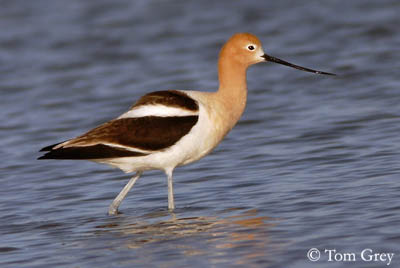
American Avocet
Recurvirostra americana
Charadriiforme Order – Recurvirostridae Family
BIOMETRICS:
Length : 43 à 51 cm
Wingspan : 72 cm
Weight : 300-460 g
LONGEVITY: Up to 9 years
DESCRIPTION:
American Avocet is a graceful wader with long, slender bill, and very long legs. It has black and white upperparts, and white underparts.
Fr: Avocette d’Amérique
All : Braunhals - Säbelschnäbler
Esp : Avoceta Americana
Ital : Avocetta americana
Nd : Noordamerikaanse Kluut
Sd : Amerikansk skärfläcka
Photographs by Tom Grey
His website:
Tom Grey's Bird Pictures
Text by Nicole Bouglouan
Sources:
HANDBOOK OF THE BIRDS OF THE WORLD Volume 3 by Josep del Hoyo-Andrew Elliott-Jordi Sargatal - Lynx Edicions - ISBN : 8487334202
FIELD GUIDE TO THE BIRDS OF NORTH AMERICA by National Geographic Society - National Geographic Society - ISBN: 0792274512
GUIDE DES LIMICOLES de D. Taylor - Delachaux et Niestlé - ISBN : 2603014080
All About Birds (Cornell Lab of Ornithology)
Animal Diversity Web (University of Michigan Museum of Zoology)
Bird Web (Seattle Audubon Society)
What Bird-The ultimate Bird Guide (Mitchell Waite)

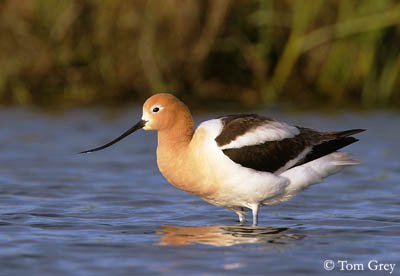
In breeding plumage, head and neck are rusty. In winter, they are grey. Wings have black outer half. The other part is white, with a black wing bar on upperpart of the wing.
Male has longer and straighter bill than female. Bill is black and curved upwards. Legs and webbed feet are greyish blue. Eyes are dark brown.
Both sexes are similar, but female is slightly smaller than male.
Juvenile shows cinnamon tinge on head and neck.
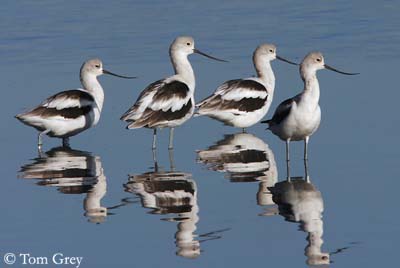
WINTER
PLUMAGE
VOICE: SOUNDS BY XENO-CANTO
American Avocet’s call is a loud “wheet” or “pleeet”. We can ear a repeated shrill “kleek”. They are noisy when an intruder enters into nest site.
HABITAT:
American Avocet is common on shallow fresh and salt waters, in ponds, marshes and lakeshores. They also live in freshwater marshes, wetlands and mudflats, and we can see them in islands (bay or coastal), and tidal flats.
RANGE:
American Avocet breeds in Western North America and some populations in Atlantic coast.
It winters in coastal California, southern Texas, Florida, Louisiana and southwards, to Guatemala.
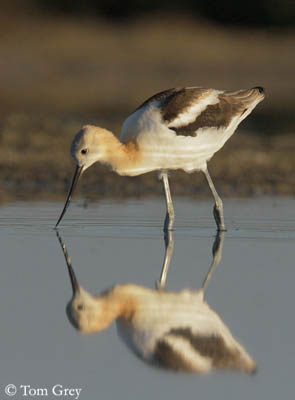
BEHAVIOUR:
American Avocet feeds by probing, swinging its long bill side to side in shallow water and mud, to get aquatic insects. It also finds crustaceans, aquatic animals and plant, at the surface of ponds and marshes. It passes with open bill going back and forth in shallow water. It captures its prey by touch.
American Avocet may feed in deep water, using “tip up” and swimming.
They may feed in large flocks, up to 100 birds. They are migratory on short distances. They form social groups and nest in colonies. It is monogamous.
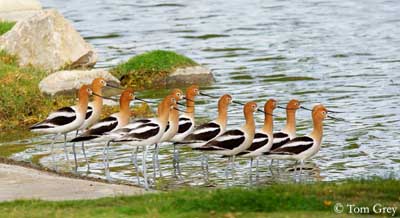
American Avocet performs an elaborate courtship display, with actions and posturing. They perform crouching, bowing postures in water or on the ground, and they dance with open wings and swaying from side to side.
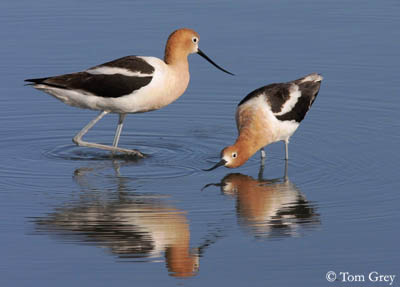
American Avocet performs displays to establish the territory and defends it. There are two pairs, or three birds, a pair and a solitary bird. They are in front of each other in a circle, and they stretch their bills towards each other. When a predator approaches, they walk towards it with a teetering gait with outstretched wings.
They also may crouch on the ground, move, and crouch again in other place. They also dive bomb when intruders appear. They may become very aggressive.
Pair builds the nest on the ground, in wet areas. If water rises, they raise the nest, adding sticks, weeds and feathers, to keep the eggs above water level.
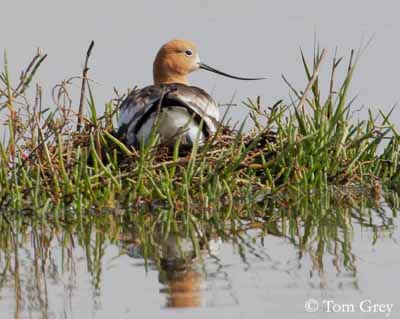
American Avocet female may parasitize other species, laying its eggs in other nest. But other species may also parasitize Avocet nest. In this case, Avocet takes care of eggs as they are their own.
FLIGHT:
When alighting, as on water or on the ground, the American Avocet keeps its wings raised until it has fairly settled.
It flies rather swift and in continue manner, with legs and neck fully extended.

REPRODUCTION:
American Avocet’s nest is a shallow depression in the ground. They scrape the soil. This depression may be lined with dry grasses and mud. Sometimes, they build platform of grass on mudflats.
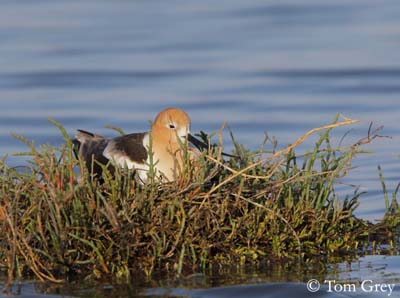
Female lays 3 to 4 olive-coloured eggs, with dark spots. Incubation lasts about 22 to 24 days, by both parents. Chicks hatch precocial, and they are very active some hours after hatching. They can feed themselves and also swim.
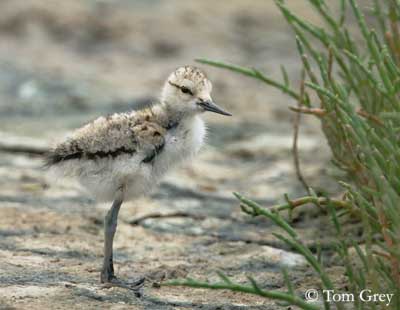
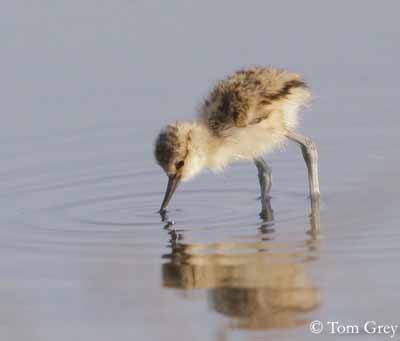
Young fledge at about 28 to 35 days after hatching.
This species produces one single brood per season.
FOOD HABITS:
American Avocet feeds on aquatic insects and animals, and shrimps and other crustaceans. It also eats aquatic plant and seeds at the surface of ponds and marshes.
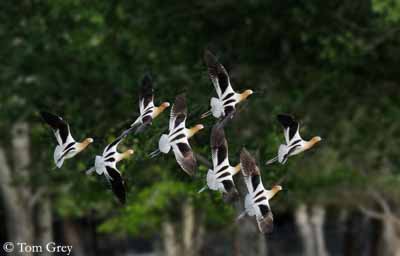

PROTECTION/ THREATS / STATUS:
American Avocet has few predators, such as skunks (Mephitidae) and foxes, which are nest predators.
American Avocet populations are increasing after important decline due to hunting in the 19th and 20th centuries. However, they are threatened by habitat loss.